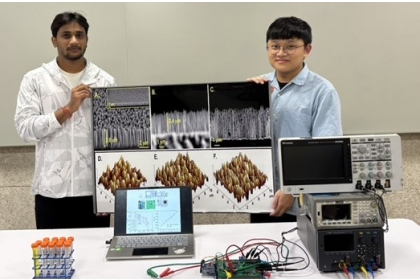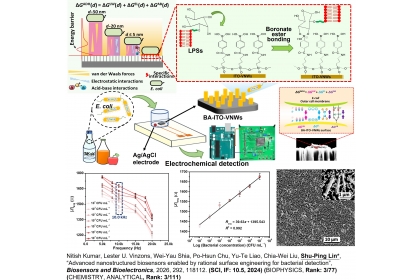Breakthrough in Foodborne Microbe Detection: NCHU Develops Nanobrush-Structured Microbial Biosensor
2025-11-06
興新聞張貼者
Unit秘書室
749
Bacterial contamination poses a persistent challenge to public health, food safety, and environmental monitoring. A research team led by Prof. Shu-Ping Lin from the Graduate Institute of Biomedical Engineering, National Chung Hsing University (NCHU), has developed a nanobrush-structured microbial biosensor capable of rapid and highly sensitive identification of Gram-specific bacteria. The study has been published in the top 3% international journal Biosensors and Bioelectronics (2024 IF: 10.5; CHEMISTRY, ANALYTICAL: Rank 3/111; BIOPHYSICS: Rank 3/77).
This work was conducted in collaboration with Prof. Yu-De Liao from the Department of Electronics and Electrical Engineering, National Yang Ming Chiao Tung University (NYCU), whose team provided a portable electrochemical impedance spectroscopy (EIS) chip that enables field-based measurements outside laboratory settings. Mr. Nitish Kumar, the first author of the study, together with Assoc. Prof. Wei-Yao Hsia from NCHU’s Department of Veterinary Medicine, further validated the biosensor’s effectiveness in detecting Gram-negative bacteria in juice and milk samples, demonstrating its potential for broader applications in food safety and medical diagnostics.
The team engineered a novel nanobrush sensing platform, where the nanobrush density was precisely controlled via semiconductor etching, and its surface was functionalized with boronic acid (BA) to enhance bacterial recognition. This surface-engineered design effectively modulates the interfacial interactions between bacterial membranes and nanostructured electrodes, greatly improving bacterial adhesion and detection sensitivity, enabling accurate detection of trace bacteria in complex environments.
Key sensing characteristics of the Nanobrush-Structured Microbial Biosensor:
• Dynamic range: from 10 to 107 CFU/mL
• Response time: within 9 minutes
• High specificity: markedly higher sensitivity to Gram-negative bacteria (e.g., E. coli) than Gram-positive bacteria (e.g., S. aureus)
• Real-time detection: compatible with portable EIS chip-based readout systems
Prof. Lin emphasized that rational surface nanostructure engineering can significantly optimize the molecular interactions between nanoscale sensors and target microbes, offering a powerful new strategy for microbial biosensing and on-site food testing.
This research stems from the NSTC-funded project “AI-Assisted Real-Time Monitoring and Rapid Diagnostic System for Swine Diseases”, led by Prof. Yu-Chan Chao, and jointly developed by interdisciplinary teams from NCHU, NYCU, and National Cheng Kung University.
The practical applicability of the developed microbial biosensor has been successfully validated in liquid food samples using portable EIS IC measurements, demonstrating its strong potential for rapid Gram-specific bacterial detection and real-world food safety diagnostics.
Paper link: https://doi.org/10.1016/j.bios.2025.118112
This work was conducted in collaboration with Prof. Yu-De Liao from the Department of Electronics and Electrical Engineering, National Yang Ming Chiao Tung University (NYCU), whose team provided a portable electrochemical impedance spectroscopy (EIS) chip that enables field-based measurements outside laboratory settings. Mr. Nitish Kumar, the first author of the study, together with Assoc. Prof. Wei-Yao Hsia from NCHU’s Department of Veterinary Medicine, further validated the biosensor’s effectiveness in detecting Gram-negative bacteria in juice and milk samples, demonstrating its potential for broader applications in food safety and medical diagnostics.
The team engineered a novel nanobrush sensing platform, where the nanobrush density was precisely controlled via semiconductor etching, and its surface was functionalized with boronic acid (BA) to enhance bacterial recognition. This surface-engineered design effectively modulates the interfacial interactions between bacterial membranes and nanostructured electrodes, greatly improving bacterial adhesion and detection sensitivity, enabling accurate detection of trace bacteria in complex environments.
Key sensing characteristics of the Nanobrush-Structured Microbial Biosensor:
• Dynamic range: from 10 to 107 CFU/mL
• Response time: within 9 minutes
• High specificity: markedly higher sensitivity to Gram-negative bacteria (e.g., E. coli) than Gram-positive bacteria (e.g., S. aureus)
• Real-time detection: compatible with portable EIS chip-based readout systems
Prof. Lin emphasized that rational surface nanostructure engineering can significantly optimize the molecular interactions between nanoscale sensors and target microbes, offering a powerful new strategy for microbial biosensing and on-site food testing.
This research stems from the NSTC-funded project “AI-Assisted Real-Time Monitoring and Rapid Diagnostic System for Swine Diseases”, led by Prof. Yu-Chan Chao, and jointly developed by interdisciplinary teams from NCHU, NYCU, and National Cheng Kung University.
The practical applicability of the developed microbial biosensor has been successfully validated in liquid food samples using portable EIS IC measurements, demonstrating its strong potential for rapid Gram-specific bacterial detection and real-world food safety diagnostics.
Paper link: https://doi.org/10.1016/j.bios.2025.118112




